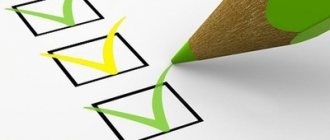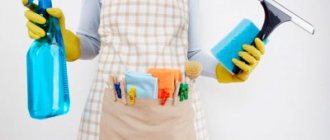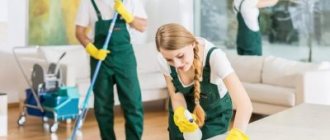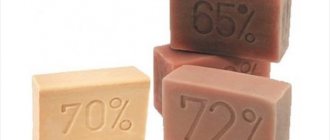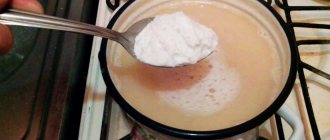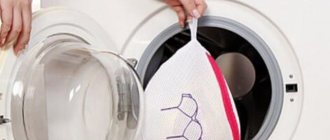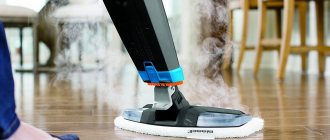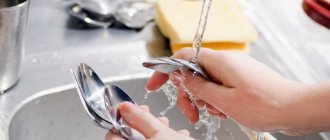Instructions for processing groups
Attention
Prepare warm water and the necessary solutions of disinfectants and detergents. It is prohibited to use electric boilers to heat water.2.3
Turn on the ventilation or open the windows (transoms) in the room to be cleaned and secure them with hooks. 3. LABOR SAFETY REQUIREMENTS DURING WORK 3.1. The premises should be cleaned:— in the absence of kindergarten students;— in washrooms and toilet rooms using disinfectants; 3.2.
Important
Do not use gasoline, kerosene or other flammable liquids when cleaning premises. 3.3. Do not wipe electrical sockets, disconnect devices and other live electrical devices with a damp cloth.3.4
SanPiN for preschool educational institutions as amended for 2022
» The education of minors in kindergartens cannot be left to chance. Taking this into account, the legislator has developed a set of detailed rules that must be followed by all preschool organizations.
The document contains requirements for the premises, regime of pupils and staff. SanPin 2.4.1. 3049-13 are sanitary and epidemiological requirements for preschool educational institutions.
Sanpin for kindergartens contains a complete list of requirements for preschool education organizations:
- admission of minors to the group;
- conditions of production and supply of food;
- requirements for the placement of preschool educational institutions;
- rules for the provision, equipment and repair of ventilation, heating, water supply and sewerage;
- and equipment of internal premises;
- sleep and wakefulness patterns;
- conditions of maintenance and equipment of the area;
- room lighting (natural and artificial);
- hygiene rules for employees.
- physical education;
Most of the rules that are regulated by SanPiN are mandatory for implementation.
But some of them are recommended for use or apply to kindergartens built or reconstructed after 2013.
In Moscow, SanPiN should be located on the official websites of each organization. Full text of SanPiN 2.4.1.3049-13
“Sanitary and epidemiological requirements for the design, content and organization of the operating mode of preschool educational organizations”
(as amended on August 27, 2015): The new SanPiN came into force in 2013. It contains a list of requirements and advice for kindergartens.
- Exemption from the rules of SanPiN of preschool educational institutions located in people's apartments or other premises of the housing stock.
- Reinforcing the need for constant ventilation of groups.
- Establishing a diet.
- The age of kindergarten students can exceed 7 years, if when the minor reaches the designated age, he has not completed his studies according to the required program.
- Correspondence of the number of beds to the number of pupils in the group.
- Establishing requirements for temperature, air inflow and outflow depending on the purpose of the room.
- Extension of the rules to organizations and groups for children under 3 years old.
- Consolidation of the nutritional plan for minors up to 2 months to 1 year.
SanPiN norms have been changed and expanded. Currently, SanPiN for kindergartens contains comprehensive information on the maintenance and upbringing of children from 2 months to the end of preschool education. Before admitting a minor to kindergarten, you must obtain a medical report, which will become the basis for assigning the child to the group.
The absence of a document gives the head of the organization the right to refuse to enroll the young person in the list of pupils. Employees of the organization (educators) are responsible for the daily admission of children to the group. They examine minors without the help of others or with the role of a medical worker.
Children with suspected illness are not allowed to join the group.
Cleaning
The premises must be kept clean, so cleaning is carried out every day. It includes washing floors, processing furniture, and removing dust. Dust is removed everywhere, including behind beds, closets, and on doors. Weekly treatments are also carried out.
Windows are treated every decade. Tables for meals and classes are washed and wiped every day. Table and bed linen, bathrobes, towels, and napkins are changed regularly. Everything dirty is stored in utility rooms until it goes into the wash. Bedding is aired 2 times a month.
Before entering the main room, children and adults take off their outerwear and change their shoes. This is necessary to maintain cleanliness in the kindergarten. Each type of work is performed regularly.
Log of disinfectant treatment of premises
A log of disinfectant treatment of premises must be kept.
Another name is a book for recording the receipt and expenditure of funds for disinfection. It contains the following information:
- Name of organization, book, start and end dates of journaling;
- Name of the object, type of activity, legal address;
- Information about the person responsible for disinfection;
- Information about the person in charge who controls the consumption of disinfectants;
- Position, surname, initials of the facility manager, his signature;
- Number and date of registration of the object with the Federal Tax Service.
This is the introductory part of the magazine. The main part states:
- Name of the object to be processed, for example, cleaning equipment, instrument disinfection, staff room, etc.;
- The number of such objects of the same type, if there are several of them;
- Area – indicated for premises, equipment, tools are skipped;
- Types of processing performed (T, G);
- Number of disinfections performed per month;
- The products used, their name and concentration;
- Consumption per unit area;
- Amount of product consumption for a single treatment;
- The need for funds used, which is calculated for one-time processing, for a month and a year.
The next section or table of the book takes into account the supply of disinfectants. This includes:
- receipt date;
- name of the product;
- number and date of the invoice according to which the transfer took place;
- volume of the drug;
- its expiration date;
- Full name of the person responsible.
Pay special attention to the column with information about invoices. The regulatory authorities on them check that disinfectants are regularly replenished and consumed. Lack of invoices will result in a fine.
Sanitary register of disinfectants (2679 Downloads)
Rules for general cleaning in preschool educational institutions
When organizing and performing “general cleaning” in any room of the kindergarten, it is important not to miss anything and to disinfect literally every little thing. The general cleaning algorithm looks like this:
- wear a robe or other overalls;
- remove all toys, teaching materials, dishes, and small equipment from the room;
- vacuum the carpets, take them out and all other textiles (curtains, linens, mattresses);
- remove dust from the room;
- Wash off serious stains using a suitable detergent;
- disinfect all surfaces, starting from the top, from the ceiling, and moving down to the furniture and floor (both wiping and irrigation with a disinfectant solution can be used);
- thoroughly rinse off the antiseptic and detergents in the same order;
- Wipe glass, wooden, varnished surfaces dry;
- Having placed the furniture in its place, ventilate the room until the smell of disinfectants completely disappears;
- bring in processed toys, textiles, etc.;
- disinfect and wash all equipment, send protective clothing for washing.
Optimal tools and equipment
For regular washing of all objects and surfaces that preschoolers may come into contact with, a soap solution is traditionally used. But the list of approved detergents used in kindergartens is constantly expanding. If possible, it is better to give preference to more modern and effective detergents. Disinfection in preschool educational institutions is carried out with antiseptics that act against bacteria and viruses (Javelion, Purzhavel, sulfochloranthin, etc.).
Equipment for cleaning each playroom, bedroom, toilet, corridors and catering unit must be separate. Tool sets are labeled and stored in special cabinets or niches. The set usually includes buckets, mops, brushes and napkins (rags), but it can be supplemented with other accessories. The main thing is that they are subject to thorough washing and disinfection.
Cleaning preschool premises: main types and features
Types of cleaning in a kindergarten include a set of measures, which involves treating furniture and surfaces, disinfecting items of use, as well as creating a favorable atmosphere in the premises. According to the degree of coverage, cleaning of preschool premises is divided into:
Daily cleaning of groups in the kindergarten is carried out to maintain constant sanitary conditions, as well as to avoid epidemiological situations. It includes the following steps:
- processing of furniture, toys, plumbing;
- dry and wet cleaning;
- ventilation of premises;
- quartzing;
- washing.
How to organize cleaning of the territory of an educational organization
Narrated by Viktor Ternovoy, Deputy General Director of Absolut Cleaning Service and Victoria Yartseva, Lawyer-Editor of the Education reference system
Each of the procedures is carried out at the frequency established by the requirements of SanPiN. Compliance with the recommended rules regarding daily cleaning in preschool educational institutions allows you to create a comfortable atmosphere in the premises, avoid the proliferation of pathogenic microflora and reduce the burden on children's immunity. Regular dust removal will prevent microparticles from entering the respiratory tract and causing allergic reactions. In clean rooms, the level of acute respiratory viral infections is significantly reduced, and control of surface treatment eliminates the risk of intestinal infections.
General cleaning of preschool premises is carried out once a month. It includes treating all surfaces and hard-to-reach places using approved detergents. Unlike daily cleaning, it covers a larger scope of work and is carried out with special care.
In addition to regularly maintaining indoor order, there are a number of procedures that help ensure that surrounding areas are clean and safe. An example of the frequency and order of actions can be seen in the table:
Cleaning of preschool premises has the same standard at any time of the year. The exception is the ventilation schedule, which varies depending on the season.
SanPin 1378-03TERMS AND DEFINITIONS
- Acaricide is a means (drug) that ensures the death of ticks.
- A bactericidal agent is a disinfectant (preparation) that ensures the death of bacteria in a vegetative form.
- A virucidal agent is a disinfectant (drug) that inactivates viruses.
- Disinsection is the killing (or repelling) of arthropods of epidemiological and sanitary-hygienic importance in order to reduce their numbers.
- Disinsection measures are measures that ensure the regulation of the number of arthropods and include a set of engineering, technical, sanitary and hygienic, exterminatory or protective measures, as well as measures to record the number of arthropods and control the effectiveness of disinsection.
- Disinfection activities - works and services, including the development, testing, production, storage, transportation, sale, use and disposal of means, equipment, materials for disinfection, sterilization, disinfestation, deratization, as well as monitoring the effectiveness and safety of these works and services.
- Disinfection measures - work on preventive disinfection (disinfection, disinfestation, deratization), focal disinfection (current and final disinfection, disinsection, deratization), as well as disinfection, pre-sterilization cleaning and sterilization of medical products.
- Disinfection - killing on objects or removing pathogenic microorganisms and their vectors from objects.
- A disinfectant (sterilizing) agent is an active principle that provides disinfection (sterilization).
- Disinfectant (sterilizing) agent is a physical or chemical agent that includes a disinfecting (sterilizing) agent - an active substance (AS).
- Deratization is the killing (or repelling) of rodents of epidemiological and sanitary-hygienic importance in order to reduce their numbers.
- Deratization measures are measures that ensure the regulation of the number of rodents and include a set of engineering, technical, sanitary and hygienic, exterminatory and protective measures, as well as measures to count the number of rodents and monitor the effectiveness of deratization.
- An insecticide is a means (drug) that ensures the death of insects.
- Disinfection is the killing or removal of pathogenic and opportunistic microorganisms from (in) environmental objects.
- Pre-sterilization cleaning - removal of contaminants from medical products to be sterilized.
- Anti-epidemic measures are a set of sanitary-hygienic, treatment-and-prophylactic, immunological, disinfection and administrative measures aimed at preventing the occurrence, localization and elimination of emerging epidemic foci of infectious and parasitic diseases.
- Repellent is a product (drug) or device that has repellent properties against various types of arthropods and rodents.
- Rodenticide is a drug (drug) that ensures the death of rodents.
- A sporicidal agent is a disinfectant (sterilizing) agent (drug) that ensures the death of microorganism spores.
- Sterilization of products is the process of killing microorganisms of all types at all stages of development on (in) products.
- A fungicidal agent is a disinfectant (preparation) that kills fungi.
Where to recycle waste, equipment and other things in your city
Sanitary and epidemiological regime in preschool educational institution 2
Recommendations from specialists > Nurse > Consultations
GENERAL CLEANING SCHEDULE
MONDAY: Cleaning the toilet room, washing utility cabinets, toilets, flush barrels, panels, partitions. TUESDAY: Cleaning the washroom, washing windows, radiators, doors, panels, trays, sinks, towel cabinets, WEDNESDAY: Cleaning the dressing room: washing windows , radiators, doors, panels. THURSDAY: Cleaning the dressing room: washing wardrobes for children, adults, dressing table. FRIDAY: Cleaning the bedroom: changing bed linen, washing beds, doors. MONDAY: Cleaning the bedroom, washing windows, radiators, panels, doors, partitions, stairs. TUESDAY: Cleaning the group room, washing windows, radiators, doors, panels. WEDNESDAY: Cleaning the group room: washing doors, furniture: tables, cabinets, chairs. THURSDAY: Cleaning the washing room: washing the buffet, stand, rubber mats, tables, panels, mesh for drying dishes. FRIDAY: changing bed linen, marking dishes, cleaning equipment, rags.
Guidelines for the use of the Purzhavel disinfectant when cleaning toilets in preschool educational institutions (SanPiN 2.4.1.1249-03)
Bathtubs, sinks, and toilets are cleaned twice a day with squeegees or brushes using detergents and disinfectants (Purzhavel).
| Disinfection object | Solution concentration according to AC% | Disinfection time (minutes) | Disinfection method |
| Plumbing equipment | 0.06 | 60 | Wipe twice |
| Kvachi | 0.06 | 60 | Dive |
• Preparation of working solutions: 0.06% conc. according to AH + 4 tablets of Purzhavel disinfectant per 10 liters of water. • All work with the product is carried out with the skin of the hands protected with rubber gloves, in the absence of people. • All containers with solutions should be closed with lids and stored in a dark, dry place, out of reach of children, for 3 days.
Guidelines for the use of the Purzhavel disinfectant when carrying out general cleaning in group premises of preschool educational institutions (SanPiN 2.4.1.1249-03)
| Solution concentration by AH % | Disinfection time (minutes) | Disinfection method |
| 0.015 | 60 | wiping |
• We prepare working solutions in enamel, glass, plastic containers by dissolving one tablet of Purzhavel in 10 liters of water; • Add 0.5% detergent to solutions used to disinfect surfaces; • General cleaning of all premises and equipment is carried out once per month, using detergents and disinfectants, furniture, walls, floors and toys are wiped with rags. Soaked in a solution of the product at the rate of 100 ml per 1 m2, or irrigate at the rate of 300 ml per 1 m2 when using a hydraulic remote control. • After disinfection is completed, the room is ventilated for 15 minutes. • Parquet floors, polished and wooden furniture are wiped with a dry cloth. • Toys are immersed in the solution, preventing them from floating up. Large toys are wiped with a rag soaked in a disinfectant solution. • Upon completion of disinfection, toys are washed with running water for 5 minutes.
Guidelines for the use of the Purzhavel disinfectant when carrying out general cleaning in the treatment room of a preschool educational institution (SanPiN 2.4.1.1249-03)
| Solution concentration by AH % | Disinfection time (minutes) | Disinfection method |
| 0.015 | 60 | wiping |
• We prepare working solutions in enamel, glass, plastic containers by dissolving one tablet of Purzhavel in 10 liters of water; • Add 0.5% detergent to the solutions used to disinfect surfaces;
Techniques for general cleaning in the treatment room of a preschool educational institution:
Modes for disinfecting objects with the disinfectant "Purzhavel" for various infections (SanPiN 2.4.1.1249-03)
| Infections | Scarlet fever | Acute intestinal infection | Viral hepatitis | Microsporia (dermatophytosis) | Disinfection method | ||||
| Objects | Conc . solution according to AX | Time of deprivation | conc. | vr | conc. | vr | conc. | vr | |
| Dinnerware with leftover food | 0.1 | 120 | 0.1 | 120 | 0.1 | 120 | 0.1 | 120 | dive |
| Linen not contaminated with secretions | 0.06 | 30 | 0.06 | 30 | 0.06 | 30 | 0.06 | 60 | soak |
| Linen contaminated with secretions | 0.2 | 120 | 0.2 | 120 | 0.2 | 120 | 0.2 | 120 | soak |
| Toys | 0.03 | 60 | 0.03 | 60 | 0.06 | 15 | 0.06 | 30 | Immersion, rubbing |
| Indoor surfaces, hard furniture | 0.015 | 60 | 0.015 | 60 | 0.015 | 60 | 0.1 | 30 | Wiping, irrigation |
| Plumbing equipment | 0.06 | 60 | 0.06 | 60 | 0.1 | 60 | 0.1 | 60 | Wipe twice |
| Cleaning equipment | 0.2 | 60 | 0.2 | 60 | 0.1 | 60 | 0.2 | 60 | Soak |
| Content of active chlorine (AC), % | Number of tablets per 10 liters of water |
| 0,015 | 1 |
| 0,03 | 2 |
| 0,06 | 4 |
| 0,1 | 7 |
| 0,2 | 14 |
| 0,3 | 20 |
Note: add 0.5% detergent to solutions used to disinfect surfaces
Landscaping of the territory of the preschool educational institution
One of the most important criteria for designing a kindergarten yard according to SanPin 2022 is a sufficient amount of green space.
- A fence made naturally from plants does not negate the installation of artificial fencing around the perimeter of the preschool educational institution.
- There is no planting of fruit-bearing trees and shrubs, poisonous or thorny plants in the area of the preschool educational institution. Greenish plantings are placed along the perimeter of the area of the preschool educational institution, which reduces the noise and dustiness of the area and creates an artificial screen from outsiders.
- In addition, green spaces are used to separate playgrounds and model the walking and economic zones of the preschool area.
Instructions for cleaning toilet rooms in kindergarten
Do not use gasoline, kerosene or other flammable liquids when cleaning premises. 3.3.
Do not wipe electrical sockets, disconnect devices and other live electrical devices with a damp cloth. 3.4.
Cleaning equipment used for cleaning toilets must not be used to clean other rooms. 4. Occupational safety requirements in emergency situations 4.1.
If detergents or disinfectants come into contact with your eyes, rinse your eyes with plenty of water and consult a doctor.
4.2. If irritation of the skin of your hands occurs as a result of using detergents and disinfectants during cleaning, wash your hands thoroughly with soap and lubricate them with nourishing cream. 4.3.
In the event of an electric shock, immediately turn off the voltage and, if the victim has no breathing or pulse, give him artificial respiration or perform an indirect (closed) cardiac massage until breathing and pulse are restored and send the victim to the nearest medical facility. 5.
Rules for cleaning the toilet in kindergarten
Equipment for cleaning each playroom, bedroom, toilet, corridors and catering unit must be separate.
Tool sets are labeled and stored in special cabinets or niches. The set usually includes buckets, mops, brushes and napkins (rags), but it can be supplemented with other accessories. The main thing is that they are subject to thorough washing and disinfection.
When organizing and performing “general cleaning” in any room of the kindergarten, it is important not to miss anything and to disinfect literally every little thing. 1.3
/ 600 hours Wet cleaning in a group: During quarantine, wet cleaning is carried out using a 0.015% solution of “Purjavel” or “Deo-chlor” (1 tablet per 10 liters of water) Schedule of general cleaning in the group.
Monday - washing windows, doors Tuesday - washing baseboards, walls Wednesday - washing furniture - tables, cabinets, chairs Thursday - washing radiators, radiator grilles Friday - washing kitchen units, stands, tables, mesh for drying dishes, walls (tiles). 1.1.
Persons at least 18 years of age who have undergone occupational safety training, a medical examination and have no contraindications due to health conditions are allowed to work cleaning premises in preschool institutions. 1.2.
Persons allowed to clean premises must comply with internal labor regulations and established work and rest schedules.
“Sanitary and epidemiological requirements for the design, content and organization of work in preschool organizations”
According to the standards, attention should be paid to the equipment of the catering unit, the conditions for storing food and their preparation. There are also standards for receiving, transporting food products and creating menus for children
carrying out repair work at the catering unit, in accordance with p.
There are also standards for receiving, transporting food and creating menus for children. carrying out repair work at the catering unit, in accordance with paragraph.
- correctional and developmental: to develop practical skills based on theoretical knowledge using PTB, to promote the correction of attention, memory, speech through specially selected exercises (according to Khudenko’s method, according to Bazarny’s method, make a definition) - correctional and educational: to promote a positive attitude towards work , desire to work, compliance with sanitary and hygienic rules when using the toilet. Cleaning in kindergartens must be done thoroughly.
Almost all Russian kindergartens are open until 16:00, so the staff has a lot of time to thoroughly clean the premises.
Foam latex, brushed toys are processed according to the manufacturer's instructions.
2% soap and soda solution – 200g. m.s. solution for 10 l. water. The use of soft stuffed toys for children's games is not allowed INSTRUCTIONS for washing tableware in a preschool educational institution Dishes and cutlery are washed in 2 or 3-cavity bathtubs installed in the pantry of each group room. SHARE Previous articleNext article
Cleaning toilets using disinfectants: how often is it done?
It is important to keep schools and kindergartens clean and safe for children. Therefore, all processes are controlled. By following the toilet cleaning schedule according to SanPin, staff reduce the risk of infection. There are also prescribed rules and regulations for cleaning.
What it is
To create optimal conditions and comfort for students and school staff, it is necessary to monitor the safety and cleanliness of the premises. Therefore, there are established norms and rules that need to be followed.
SanPin for schools is a document that regulates the operation of educational institutions. Helps make training and its mode safe for its participants. Hygienic requirements for maintaining cleanliness change periodically.
The regulatory document contains requirements for the location of the building, the selection of equipment, and equipment. The standards for air-thermal conditions, lighting sources, and the organization of medical care are described. Hygiene requirements specify how to ensure cleanliness in different types of premises.
You can find a set of information about how often bathrooms are cleaned at school, according to the requirements.
According to the established schedule, bathrooms in schools and kindergartens are cleaned according to SanPin. This is a place of increased risk of spreading infection. He should get a lot of attention. The document contains information on how to disinfect surfaces.
When establishing the schedule and rules for cleaning and disinfecting premises in schools, SanPin requirements must be used. According to them, cleaning products and equipment are selected that will be used to clean the toilet.
Instructions for cleaning bathrooms
Aseptic cleaning procedure in the toilet
Cleaning the toilet should be carried out according to the established algorithm. This helps to achieve maximum cleanliness in the room. The process is described and approved in detail.
Instructions for cleaning the toilet at school:
- Prepare cleaning supplies and necessary equipment.
- Disinfect your hands and prepare your clothes.
- Put up a sign warning about wet fields.
- Turn on the light and empty the trash bin. Drain the water from the barrel. Remove water from the toilet using a brush. Check that the unit is not clogged.
- Apply disinfectant to edges and rim. Leave for a while.
- Wipe surfaces with a dampened cloth, including mirrors, soap dishes, and dispensers.
- Clean the walls from dirt at least 1 meter from the floor.
- Wipe down switches and door handles.
- Wash the sink, faucet and other parts.
- Wipe the tank, toilet seat, and outer surface with a disinfectant. Repeat with a dry cloth.
- Pour the disinfectant into the brush container and place it there.
- Clean the trash container.
- Ventilate the room.
- Treat the door handle when exiting.
- Disinfect equipment that was used and dry it.
- Wash the hands.
Important! If the disinfectant must be washed off, the cleaner must additionally treat the surfaces with a clean napkin.
In a school or kindergarten, you need to keep the premises clean. It is important to pay special attention to bathrooms. There is a risk of infection in this place, just like in a clinic or other medical facility.
Established standards
Every time after cleaning you need to replenish toiletries.
Toilets must be wet cleaned daily. But there is a technological map that accurately indicates the frequency of processing of different surfaces. The cleaner must comply with established rules and regulations.
Two rules to apply when cleaning:
- Brush brushes should have replaceable bristles. It is changed 4 times a year. Or once every 3 months. Can be done more often as needed. It is recommended to choose black brushes;
- Cleaning is not limited to cleaning surfaces. Every time after work you need to replenish toilet paper, towels, soap and other supplies.
How often to disinfect:
- mirrors are cleaned daily;
- The walls are washed 1 meter high every day. Once a month they clean all the way to the ceiling;
- sanitary equipment is disinfected constantly, every day;
- door handles and blocks are disinfected every time after continuous cleaning;
- Clean the ventilation grilles every 3 months;
- Wet cleaning and trash removal are carried out daily.
The documents contain rules that explain how many times a week you need to clean each part of the bathroom. The nuances that every employee of an educational institution needs to know are also indicated.
Inventory
There are requirements for equipment and detergents that can be used during cleaning. They must be safe and effective. And the employee must have a uniform.
Rules for the selection and storage of equipment and disinfectants:
- cleaning equipment should not be stored in the school toilet, but in a special storage room;
- containers and other accessories should be marked in different colors depending on the room for which they are used;
- buckets must be signed so as not to be confused;
- It is allowed to use only equipment that is subject to disinfection;
- after each use, rags, rags and other devices are disinfected;
- chloramine solution, Samarovka, Clorosept are used as disinfectants. Devices are treated in each disinfectant liquid for at least an hour;
- Rags for floors and walls in the toilet room should be separate.
You cannot wash the gym and the bathroom with the same rags, or use the same equipment. It is recommended to have a separate disinfectant solution.
Before cleaning, the employee must prepare. The work uses gloves, an apron, and a long-sleeved uniform. Disinfectants should not damage the skin. It is not recommended to hire people with sensitive skin.
Important! To ensure proper order in the school, you need to have an industrial vacuum cleaner.
Sample graph
According to the rules, cleaning must take place according to the established schedule. The employee must report by signing the schedule. This helps to properly organize the process of cleaning the entire school.
Only regular cleaning can guarantee the safety of students and staff. It must be carried out in accordance with the requirements of SanPin. The cleaning lady is required to ensure cleanliness every day.
After completing each shift, you need to wash the floor, toilet and sink, taps, windows and mirrors using special products, and trash cans. According to the rules, cleaning is carried out at least 2 times a day.
If there are 2 shifts in an educational institution, then at the end of each shift attention is paid to the condition of the bathroom.
Surfaces in school bathrooms must be disinfected according to an approved schedule. The most contaminated area in an educational institution must be cleaned at least 2 times a day. It is important to plan the event while the children are in class.
The bathroom is the most dangerous and dirty place in an educational institution. Therefore, cleaning must be carried out in compliance with the requirements. There is an established process algorithm, rules for choosing detergents and equipment.
Source: https://kliningovyj-raj.ru/uborka/grafik-tualeta-po-sanpinu/
What is the difference between general cleaning in a kindergarten?
Children want to try and explore everything, often put toys in their mouths, and forget to wash their hands on time. Two important conclusions follow from this:
- the kindergarten should be perfectly clean;
- here you need to use only hypoallergenic detergents and thoroughly rinse them off all items.
To ensure that cleanliness is maintained at the proper level, a full-time health worker develops a schedule of general cleaning in the preschool educational institution and detailed instructions for their implementation. Washing and disinfection of kindergarten premises should be carried out monthly. Since it is almost impossible to clean the entire kindergarten at the same time, one day is allocated for each zone. It is forbidden to carry out general cleaning in the presence of children.
Filling samples
This is an example of filling out a general cleaning log:
And this is an example of a completed log of work on sanitary treatment of premises:
This is what the current cleaning record book looks like:
| LLC "Clubtk.ru" | 08:00 | Reception | Wet cleaning of floors and wiping furniture and surfaces | "Khimitek Polyprom" 10% and "Sulfochloranthin-D" 5% | Sidorova | Alekseeva | |
| 2 | 25.08.2021 | 08:20 | Conference hall | Wet | "Khimitek Polyprom" 10% | Sidorova | Alekseeva |
| 3 | 25.08.2021 | 08:35 | Employees' offices | Wet | "Aqua-chlor" 10% | Sidorova | Alekseeva |
